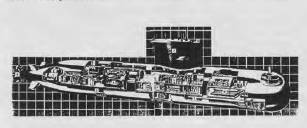- Author
- Smith, Peter
- Subjects
- Ship design and development
- Tags
-
- RAN Ships
- HMAS Oxley I, HMAS Otway I, HMAS Orion, HMAS K9, HMAS Collins, HMAS Watson (base), HMAS Penguin (Shore Base - Balmoral), HMAS Penguin I, HMAS Oxley II, HMAS Stirling (Shore establishment), HMAS Ovens, HMAS Otama, HMAS Onslow, HMAS AE1, HMAS AE2
- Publication
- June 1993 edition of the Naval Historical Review (all rights reserved)
Another Era Begins
The re-birth of Australia’s submarine service began in 1963 when an order was placed for four British Oberon class vessels. The boats, each taking around three years to build, were assembled at Greenock in Scotland and, on commissioning, were manned almost entirely by RAN officers and sailors who had received extensive training on RN submarines to prepare them for the task of establishing Australia’s submarine arm.
August 18, 1967 was a significant day in the RAN’s history, marking not only the arrival of the first of the Oberons, HMAS OXLEY, but also the commissioning of the submarine base HMAS PLATYPUS and the establishment of the Australian Submarine Squadron. The submarine arm was on its way.
The following three years saw the arrival of OTWAY, OVENS and ONSLOW and in 1971, impressed by the capabilities of the Oberons, the Navy placed an order for a further two boats. ORION and OTAMA arrived in 1977 and 1978, and in the years from 1979 to 1985 all six submarines were updated as part of the Submarine Weapons Update Program (SWUP). SWUP was a major exercise, providing a new fire control system, improved attack sonar, fitting of the Mk 48 torpedo and the ability to launch the Harpoon missile. The Oberons were no longer considered merely as anti-submarine warfare `training aids’ – they were recognised as a formidable weapon.
HMAS OXLEY achieved a “first” when, as part of the “two ocean basing” policy she was the first submarine to be homeported at HMAS STIRLING in WA.

Decommissioned in February 1992, she was soon replaced by HMAS ORION which since then has adopted the nickname “West Coast Warrior”.
The Oberons, although reaching the end of their life and in the process of being replaced by the Collins Class, are still a reliable submarine and have provided impressive service to the Navy in their 25 year history. A submariner involved in the new submarine program remarked that if the decision to buy the Collins was as good as the decision to purchase the Oberons, then Australia’s submarine future was in good shape – a tribute to the `old guard’.
Submarine Training and Systems Centre
The Submarine Training and Systems Centre (STSC) situated at HMAS STIRLING, Garden Island, Western Australia, has been purpose built by the Royal Australian Navy initially to train personnel who will operate and maintain the new COLLINS Class submarine. At a later stage, the Centre will be expanded to encompass the functions of the Submarine Warfare and Systems Centre, presently located at HMAS WATSON, in Sydney. The operation of the STSC has been licensed to the Australian Submarine Corporation (ASC), builders of the COLLINS Class submarine, to install equipment and simulators and to conduct and evaluate training.
Into the 21st Century
As the decade draws to an end, an exciting new era for the Royal Australian Navy’s submarine arm is about to begin. The signing of a contract between the Government and the Australian Submarine Corporation (ASC) on 3rd June, 1987 for the design and construction of six submarines, signalled the start of a massive project which will take the RAN submariners into the 21st century.

The “state-of-the-art” Collins Class Type 471 submarines will be a combination of proven technology and the latest developments, specially designed for Australia’s unique geographic and strategic circumstances. The boats will be the best of their kind in the world with capabilities that are vital to Australia, like the ability to stay on patrol for extended periods far from their base.
Type 471 (Collins Class) is a conventionally powered diesel-electric submarine, 75 metres in length, about 8 metres in diameter and having a displacement of some 2,500 tonnes.
Using a technique pioneered by Swedish engineers, the Collins Class will be constructed in separate sections. The almost completed modules will then be assembled at ASC’s facility in Adelaide. Sections 300 and 600 of HMAS COLLINS, the first of the new submarines, were built at the Kockums shipyard in Sweden and shipped to Adelaide, but the remaining five boats will be built entirely in Australia. Most of the internal equipment is mounted on platforms which are then inserted into the appropriate submarine section. With the traditional method of submarine building, the hull was completed before each system was installed.




